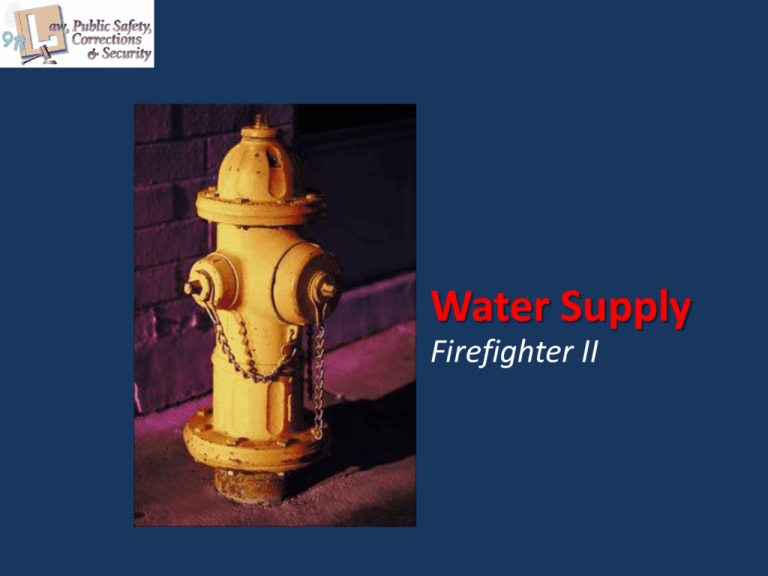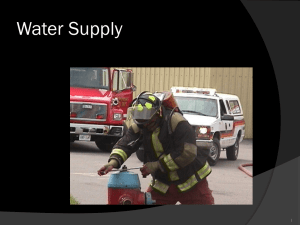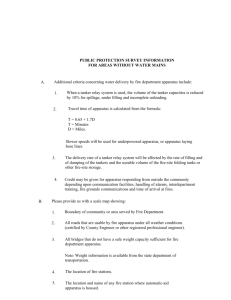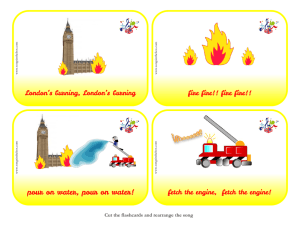
Water Supply
Firefighter II
Copyright and Terms of Service
Copyright © Texas Education Agency, 2011. These materials are copyrighted © and trademarked ™ as
the property of the Texas Education Agency (TEA) and may not be reproduced without the express
written permission of TEA, except under the following conditions:
1) Texas public school districts, charter schools, and Education Service Centers may reproduce and use
copies of the Materials and Related Materials for the districts’ and schools’ educational use without
obtaining permission from TEA.
2) Residents of the state of Texas may reproduce and use copies of the Materials and Related Materials
for individual personal use only, without obtaining written permission of TEA.
3) Any portion reproduced must be reproduced in its entirety and remain unedited, unaltered and
unchanged in any way.
4) No monetary charge can be made for the reproduced materials or any document containing them;
however, a reasonable charge to cover only the cost of reproduction and distribution may be
charged.
Private entities or persons located in Texas that are not Texas public school districts, Texas Education
Service Centers, or Texas charter schools or any entity, whether public or private, educational or noneducational, located outside the state of Texas MUST obtain written approval from TEA and will be
required to enter into a license agreement that may involve the payment of a licensing fee or a royalty.
Contact TEA Copyrights with any questions you may have.
Copyright © Texas Education Agency 2012. All rights reserved.
Images and other multimedia content used with permission.
2
Fire Hydrants
• Dry-barrel hydrants
– Installed where hydrants are subject to prolonged
freezing temperatures
– The main valve is located below the frost line to
prevent water from entering the hydrant barrel
– The stem nut for the main valve is located at the top
of the hydrant
• Turning the nut counterclockwise opens the valve
allowing water into the hydrant
• Turning the nut clockwise closes the valve, raising the
drain valve plate which opens the drain holes and causes
the barrel to empty
Copyright © Texas Education Agency 2012. All rights reserved.
Images and other multimedia content used with permission.
3
Fire Hydrants (continued)
• There is a process to verify that the water is
draining from the hydrant
– Close the main valve until resistance is met, and
then give it another ¼-turn
– Cap all but one discharge
– Place a hand over the open discharge – if the
hydrant is draining, a slight vacuum is felt; if
not, repeat the previous steps
Copyright © Texas Education Agency 2012. All rights reserved.
Images and other multimedia content used with permission.
4
Fire Hydrants (continued)
• Wet-barrel hydrants
– Sometimes referred to as “frost free” or
“California” hydrants
– Installed in climates where prolonged freezing
is uncommon
– Have a compression valve on each outlet that
needs to be turned counterclockwise to open it
– Do not drain when all of the valves are closed;
the barrel stays filled with water
Copyright © Texas Education Agency 2012. All rights reserved.
Images and other multimedia content used with permission.
5
NFPA Hydrant Color Code
• Class AA/Light Blue/1500 gallons per
minute (gpm) or greater
• Class A/Green/1000–1499 gpm
• Class B/Orange/500–999 gpm
• Class C/Red/less than 500 gpm
Copyright © Texas Education Agency 2012. All rights reserved.
Images and other multimedia content used with permission.
6
Making Hydrant Connections
• Associated tools
– Combination spanner/hydrant wrench
– Four-way hydrant valve – check local Standard
Operating Procedures (SOPs)
– Items may be kept readily accessible in a tool pouch
– The firefighter making the hydrant connection
should maintain radio communication with the
pump operator as to when to supply water from the
hydrant (some departments use an audio or hand
signal in addition to, or in place of, radio
communication)
Copyright © Texas Education Agency 2012. All rights reserved.
Images and other multimedia content used with permission.
7
Making Hydrant Connections (continued)
• Hydrant connection procedure for a forward
lay (hose laid from the water source to the fire)
– The firefighter
• Takes the necessary tools to make the hydrant connection
• Removes sufficient hose from the supply bed to “wrap”
the hydrant
• Wraps the hose around the base of the hydrant, and
effectively anchors the hose to it
• Signals the driver/operator to proceed to the fire
(forward lay)
• Makes the proper hose connections to the hydrant
Copyright © Texas Education Agency 2012. All rights reserved.
Images and other multimedia content used with permission.
8
Making Hydrant Connections (continued)
• Using a four-way valve
– Four-way valves allow
• Forward laid supply lines to be charged immediately
• Additional pumpers to connect to the hydrant
– The second pumper either supplies more lines or
boosts the pressure of the original supply line
– Typically, the four-way valve is pre-connected to
the supply line, to be readily connected to the
hydrant
• This allows the firefighter “catching” the hydrant to have
to complete only the one task of making the valve
connection to the hydrant
Copyright © Texas Education Agency 2012. All rights reserved.
Images and other multimedia content used with permission.
9
Making Hydrant Connections (continued)
• Reverse lay (hose laid from the fire to the
water source)
– The method used when firefighters
•
•
•
•
Take the apparatus to the fire location
Complete a size-up before laying a supply line
Leave the necessary equipment at the scene
Lay the supply line back to the water source
– Used primarily when drafting, or when there is a
need to boost hydrant pressure for the supply lines
– There is often an SOP for setting up relay
operations with 2½- or 3-inch supply lines
Copyright © Texas Education Agency 2012. All rights reserved.
Images and other multimedia content used with permission.
10
Making Hydrant Connections (continued)
• Reverse lay (continued)
– Some disadvantages
• Leaving essential equipment before laying the supply
lines can cause delays in the initial attack of a fire
• One firefighter is obligated to remain with the pumper at
the water source as opposed to being at the fire scene
– Does not require the employ of a four-way valve
– Can be used when one pumper is alone for an
extended period of time and the hose used in the
reverse lay becomes the attack line (often used with
a wye and a 1½- or 1¾-inch attack assembly)
Copyright © Texas Education Agency 2012. All rights reserved.
Images and other multimedia content used with permission.
11
Making Hydrant Connections (continued)
• Reverse lay (continued)
– Reverse lays when using two pumpers
• One arrives at the scene and begins extinguishment
operations
• The second lays a supply line back to the water
source
• That line is connected to the intake side of the first
pumper at the scene
Copyright © Texas Education Agency 2012. All rights reserved.
Images and other multimedia content used with permission.
12
Hydrant Connections
with a Soft Intake Hose
• A firefighter will assist the pump operator in making
a soft intake hydrant connection
• Some hydrants are not capable of making a large
soft intake hose connection because they are not
equipped with a steamer connection; therefore, only
a smaller dimension supply hose can be used
• It is more efficient use of a hydrant if a connection
can be made to a large steamer connection with a
4½-inch or larger supply line
• Because a hydrant is a pressurized water source, a
soft intake hose is appropriate and works effectively
Copyright © Texas Education Agency 2012. All rights reserved.
Images and other multimedia content used with permission.
13
Hydrant Connections
with a Hard Intake Hose
• If a hard intake hose is marked “For Vacuum Use Only,”
do not use it for hydrant connections; this type of hard
intake hose is meant for drafting operations only
• This method may require the coordination of more people
to attach than the connection with a soft intake hose would
• The positioning of the pumper prior to making the
connection is critical (depending on the apparatus,
connections may be possible from either the side, front, or
rear of the apparatus)
• It is good practice to stop the apparatus just short of the
hydrant and jockey the apparatus into position in order to
make the connection
• Making this type of connection takes practice and
precision
Copyright © Texas Education Agency 2012. All rights reserved.
Images and other multimedia content used with permission.
14
Meeting Water Needs
• Hydrant connections need to be made correctly
for the following reasons:
– To sustain the fire flow requirements and pressure
needs of the systems and the appliances served
– To effectively save lives and property from fire
damage
– To avoid tragedies caused by ineffective pumper-tohydrant connections
• A poor or no water supply for extinguishment endangers
the building occupants and the firefighters
• A poor or no water supply can result in poor exposure
protection and the extension of the fire beyond the
building of origin
Copyright © Texas Education Agency 2012. All rights reserved.
Images and other multimedia content used with permission.
15
Meeting Water Needs (continued)
• Firefighters should know the normal and flow
pressures of water distribution systems, as well
as their flow capacities
– High flow/high pressure systems or areas can be an
advantage to firefighting operations
– Low flow/low pressure systems or areas should be
avoided if possible
– When pumping from a hydrant, the recommended
low residual pressure is 20 psi
– Average pressures in water distribution systems in
the United States are between 65 and 80 psi, with a
typical minimum residual pressure of 20 psi
Copyright © Texas Education Agency 2012. All rights reserved.
Images and other multimedia content used with permission.
16
Rural Water Supply Operations
• Water shuttles are recommended for distances greater
than half a mile, or distances greater than the supply
line capability of the department
• Tools and/or equipment needed
–
–
–
–
–
–
–
–
Attack engine (pumper)
Supply line
Supply engine
Low level strainers
Portable tank(s)
Water tenders
Drafting engine (unless self-filling vacuum tenders are used)
Water source
Copyright © Texas Education Agency 2012. All rights reserved.
Images and other multimedia content used with permission.
17
Rural Water Supply Operations
(continued)
• Relay pumping
– In some situations, the water source is close enough to the
scene (within supply line capability of the department, and
closer than ½ mile) that relay pumping can be used instead
of water shuttles
– Two factors to consider
• Is the water supply capable of maintaining the necessary volume of
water for the time required to mitigate the incident?
• Can the relay operation be set up quickly enough to be effective?
– Tools and/or equipment needed
•
•
•
•
Water supply
Apparatus with the greatest pumping capacity at the water source
Large diameter supply hose
Attack pumper
Copyright © Texas Education Agency 2012. All rights reserved.
Images and other multimedia content used with permission.
18
Resources
• 0135151112, Essentials of Firefighting (5th
Edition), International Fire Service Training
Association (IFSTA), 2008
• 1428339825, Firefighter's Handbook:
Firefighter I and Firefighter II (1st Edition),
Delmar Cengage Learning, 2008
Copyright © Texas Education Agency 2012. All rights reserved.
Images and other multimedia content used with permission.
19







